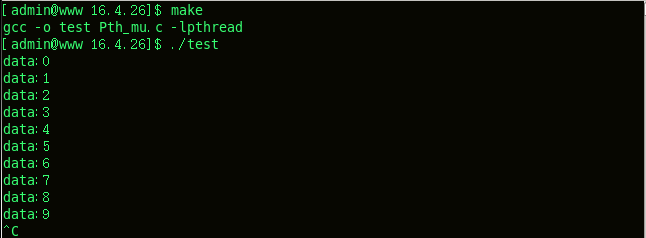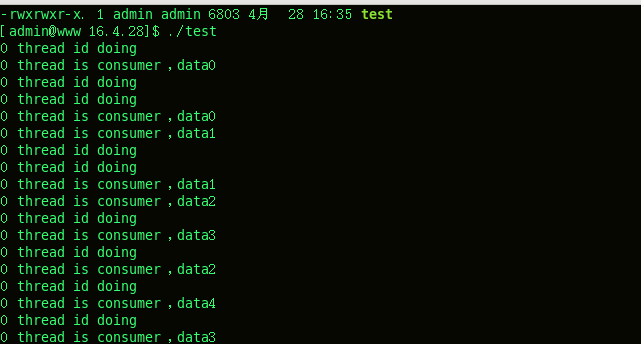生产者:生产数据
消费者:消费数据
提供场所:缓冲区,eg:超市
生产者消费者特点:三种关系,两类人,一个场所
三种关系指的是:生产者与生产者之间是互斥关系
消费者与消费者之间是互斥关系
生产者与消费者之间是同步与互斥关系
两类人:生产者,消费者
一个场所:存储数据(此处用带头单链表实现)
单生产者单消费者模式:此例取数据方式为FIFO先进先出。
利用互斥锁实现单生产者单消费者模式。
#include#include #include typedef int _dataType; typedef int *_dataType_p; typedef struct _node{ _dataType data; struct _node* next; }node,*nodep,**nodepp; nodep head = NULL; pthread_mutex_t mutex = PTHREAD_MUTEX_INITIALIZER; nodep buyNode(_dataType val) { nodep tmp = (nodep)malloc(sizeof(node)); if(tmp!= NULL) { tmp->data = val; tmp->next = NULL; return tmp; } return NULL; } void init(nodepp head) { *head = buyNode(0); } //存在头节点。 void push_list(nodep head,_dataType val) { nodep tmp = buyNode(val); tmp->next = head->next; head->next = tmp; } int pop_back_list(nodep head,_dataType_p pval) { //当之存在一个哨兵位的时候. if(NULL == head->next) return -1; nodep index = head; while(NULL != index->next->next) { index = index->next; } nodep del = index->next; *pval = del->data; index->next = del->next; free(del); return 0; } void* product(void* arg) { _dataType i = 0; while(1) { sleep(1); pthread_mutex_lock(&mutex); push_list(head,i++); pthread_mutex_unlock(&mutex); } pthread_exit((void *)1); } void* consumer(void *arg) { _dataType val = 0; while(1){ sleep(2); pthread_mutex_lock(&mutex); if(pop_back_list(head,&val) == -1) { pthread_mutex_unlock(&mutex); continue; } printf("data:%d\n",val); pthread_mutex_unlock(&mutex); } pthread_exit((void *)1); } int main() { pthread_t tid1,tid2; init(&head); pthread_create(&tid1,NULL,product,NULL); pthread_create(&tid2,NULL,consumer,NULL); pthread_join(tid1,NULL); pthread_join(tid2,NULL); free(head); pthread_mutex_destroy(&mutex); return 0; }
运行结果:
然后我们说一说条件变量:
线程间的同步还有这样一种情况:线程A需要等某个条件成立才能继续往下执行,现在这个条
件不成立,线程A就阻塞等待,而线程B在执行过程中使这个条件成立了,就唤醒线程A继续执
行。 在pthread库中通过条件变量(Condition Variable)来阻塞等待一个条件,或者唤醒等待这个
条件的线程。Condition Variable用pthread_cond_t类型的变量表示,可以这样初始化和销毁:
返回值:成功返回0,失败返回错误号。
和Mutex的初始化和销毁类似,pthread_cond_init函数初始化.一个Condition Variable,attr参数为
NULL则表.示缺省属性,pthread_cond_destroy函数销毁.一个Condition Variable。如果Condition
Variable是静态分配的,也可以.用宏定义PTHEAD_COND_INITIALIZER初始化,相当于 .用
pthread_cond_init函数初始化并且attr参数为NULL。Condition Variable的操作可以
用下列函数:
返回值:成功返回0,失败返回错误号。
可见,一个Condition Variable总是和一个Mutex搭配使用的。一个线程可以调用
pthread_cond_wait在一个Condition Variable上阻塞等待,这个函数做以下三步操作:
1. 释放Mutex
2. 阻塞等待
3. 当被唤醒时,重新获得Mutex并返回
pthread_cond_timedwait函数还有一个额外的参数可以设定等待超时,如果到达了abstime所指定的时刻仍然没有别的线程来唤醒当前线程,就返回ETIMEDOUT。一个线程可以调用
pthread_cond_signal唤醒在某个Condition Variable上等待的另一个线程,也可以调用
pthread_cond_broadcast唤醒在这个Condition Variable上等待的所有线程。
我们用条件变量来写一个单生产者单消费者模式:
#include#include #include typedef int _dataType; typedef int *_dataType_p; typedef struct _node{ _dataType data; struct _node* next; }node,*nodep,**nodepp; nodep head = NULL; pthread_mutex_t mutex = PTHREAD_MUTEX_INITIALIZER; pthread_cond_t cond = PTHREAD_COND_INITIALIZER; nodep buyNode(_dataType val) { nodep tmp = (nodep)malloc(sizeof(node)); if(tmp!= NULL) { tmp->data = val; tmp->next = NULL; return tmp; } return NULL; } void init(nodepp head) { *head = buyNode(0); } void push_list(nodep head,_dataType val) { nodep tmp = buyNode(val); tmp->next = head->next; head->next = tmp; } int pop_list(nodep head,_dataType_p pval) { if(NULL == head->next) return -1; nodep del = head->next; *pval = del->data; head->next = del->next; free(del); return 0; } void* product(void* arg) { _dataType i = 0; while(1) { sleep(1); pthread_mutex_lock(&mutex); push_list(head,i++); pthread_cond_signal(&cond); pthread_mutex_unlock(&mutex); } pthread_exit((void *)1); } void* consumer(void *arg) { _dataType val = 0; while(1){ sleep(1); pthread_mutex_lock(&mutex); if(pop_list(head,&val) == -1) pthread_cond_wait(&cond,&mutex); printf("data:%d\n",val); pthread_mutex_unlock(&mutex); } pthread_exit((void *)1); } int main() { pthread_t tid1,tid2; init(&head); pthread_create(&tid1,NULL,product,NULL); pthread_create(&tid2,NULL,consumer,NULL); pthread_join(tid1,NULL); pthread_join(tid2,NULL); free(head); pthread_mutex_destroy(&mutex); return 0; }
运行结果同互斥锁一样。
信号量:
Mutex变量是非0即1的,可看作一种资源的可用数量,初始化时Mutex是1,表示有一个可用资源, 加锁时获得该资源,将Mutex减到0,表示不再有可用资源,解锁时释放该资源,将Mutex重新加到1,表示又有了一个可 用资源。
信号量(Semaphore)和Mutex类似,表示可用资源的数量,和Mutex不同的是这个数量可以大于
1。即,如果信号量描述的资源数目是1时,此时的信号量和互斥锁相同!
本节介绍的是POSIX semaphore库函数,详见sem_overview(7),这种信号量不仅可用于同一进程 的线程间同步,也可用于不同进程间的同步。
semaphore变量的类型为sem_t,sem_init()初始化一个semaphore变量,value参数表示可用资源的数量,pshared参数为0表示信号量用于同一进程的线程间同步,在用完semaphore变量之后应该调用sem_destroy()释放与semaphore相关的资源。
调用sem_wait()可以获得资源(P操作),使semaphore的值减1,如果调用sem_wait()时
semaphore的值已 经是0,则挂起等待。如果不希望挂起等待,可以调用sem_trywait() 。调用
sem_post() 可以释放资源(V操作),使semaphore 的值加1,同时唤醒挂起等待的线程。
上面生产者-消费者的例子是基于链表的,其空间可以动态分配,现在基于固定大小的环形队
列重写这个程序(POSIX信号量):
#include#include #include #define _SEM_PRO_ 20 #define _SEM_COM_ 0 typedef int _dataType; _dataType blank[_SEM_PRO_]; sem_t sem_product; sem_t sem_consumer; void *product(void *arg) { int index = 0; int count = 0; while(1) { sleep(rand()%5); sem_wait(&sem_product); blank[index++] = count ++; sem_post(&sem_consumer); index %= _SEM_PRO_; } pthread_exit((void *)1); } void* consumer(void * arg) { int index = 0; while(1) { sem_wait(&sem_consumer); printf("data%d\n",blank[index++]); sem_post(&sem_product); index %= _SEM_PRO_; } pthread_exit((void*)1); } int main() { pthread_t tid1,tid2; sem_init(&sem_product,0,20); sem_init(&sem_consumer,0,0); pthread_create(&tid1,NULL,product,NULL); pthread_create(&tid2,NULL,consumer,NULL); pthread_join(tid1,NULL); pthread_join(tid2,NULL); sem_destroy(&sem_product); sem_destroy(&sem_consumer); return 0; }
运行结果同上。
最后我们运用信号量来实现一个多消费者多生产者模式:
#include#include #include #define _SEM_PRO_ 20 #define _SEM_COM_ 0 typedef int _dataType; _dataType blank[_SEM_PRO_]; sem_t sem_product; sem_t sem_consumer; pthread_mutex_t mutex_product = PTHREAD_MUTEX_INITIALIZER; pthread_mutex_t mutex_consumer = PTHREAD_MUTEX_INITIALIZER; void *product(void *arg) { int index = 0; int count = 0; while(1) { sleep(rand()%5); sem_wait(&sem_product); pthread_mutex_lock(&mutex_product); printf("%d thread id doing\n",(int )arg); blank[index++] = count ++; index %= _SEM_PRO_; pthread_mutex_unlock(&mutex_product); sem_post(&sem_consumer); } pthread_exit((void *)1); } void* consumer(void * arg) { int index = 0; while(1) { sem_wait(&sem_consumer); pthread_mutex_lock(&mutex_consumer); printf("%d thread is consumer ,data%d\n",(int)arg,blank[index++]); index %= _SEM_PRO_; pthread_mutex_unlock(&mutex_consumer); sem_post(&sem_product); } pthread_exit((void*)1); } int main() { pthread_t tid1,tid2,tid3,tid4; sem_init(&sem_product,0,20); sem_init(&sem_consumer,0,0); pthread_create(&tid1,NULL,product,NULL); pthread_create(&tid1,NULL,product,NULL); pthread_create(&tid3,NULL,consumer,NULL); pthread_create(&tid4,NULL,consumer,NULL); pthread_join(tid1,NULL); pthread_join(tid2,NULL); pthread_join(tid3,NULL); pthread_join(tid4,NULL); sem_destroy(&sem_product); sem_destroy(&sem_consumer); pthread_mutex_destroy(&mutex_product); pthread_mutex_destroy(&mutex_consumer); return 0; }
运行结果:
总结:
其实本篇是借助生产者消费者模式来讲解线程的互斥锁,条件变量,信号量的操作。
对于生产者/消费者模型我们只需要记住三种关系,两类人,一个场所
三种关系指的是:生产者与生产者之间是互斥关系
消费者与消费者之间是互斥关系
生产者与消费者之间是同步与互斥关系
两类人:生产者,消费者
一个场所:存储数据。
然后对于生产者/消费者我以后会单独写一篇博客进行描述。
一定要熟悉运用本篇中的线程操作函数。





